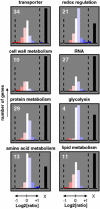Combined transcript and metabolite profiling of Arabidopsis leaves reveals fundamental effects of the thiol-disulfide status on plant metabolism
- PMID: 16648214
- PMCID: PMC1475465
- DOI: 10.1104/pp.106.081208
Combined transcript and metabolite profiling of Arabidopsis leaves reveals fundamental effects of the thiol-disulfide status on plant metabolism
Abstract
In this study, we used gas chromatography-mass spectrometry analysis in combination with flux analysis and the Affymetrix ATH1 GeneChip to survey the metabolome and transcriptome of Arabidopsis (Arabidopsis thaliana) leaves in response to manipulation of the thiol-disulfide status. Feeding low concentrations of the sulfhydryl reagent dithiothreitol for 1 h at the end of the dark period led to posttranslational redox activation of ADP-glucose pyrophosphorylase and major alterations in leaf carbon partitioning, including an increased flux into major respiratory pathways, starch, cell wall, and amino acid synthesis, and a reduced flux to sucrose. This was accompanied by a decrease in the levels of hexose phosphates, while metabolites in the second half of the tricarboxylic acid cycle and various amino acids increased, indicating a stimulation of anaplerotic fluxes reliant on alpha-ketoglutarate. There was also an increase in shikimate as a precursor of secondary plant products and marked changes in the levels of the minor sugars involved in ascorbate synthesis and cell wall metabolism. Transcript profiling revealed a relatively small number of changes in the levels of transcripts coding for components of redox regulation, transport processes, and cell wall, protein, and amino acid metabolism, while there were no major alterations in transcript levels coding for enzymes involved in central metabolic pathways. These results provide a global picture of the effect of redox and reveal the utility of transcript and metabolite profiling as systemic strategies to uncover the occurrence of redox modulation in vivo.
Figures




References
-
- Ashton AR, Burnell JN, Furbank RT, Jenkins CD, Hatch MD (1990) Enzymes of C4 photosynthesis. In PM Dey, JB Harborne, eds, Methods in Plant Biochemistry, Vol 3. Academic Press, San Diego, pp 39–72
-
- Baier M, Dietz KJ (2005) Chloroplasts as source and target of cellular redox regulation: a discussion on chloroplast redox signals in the context of plant physiology. J Exp Bot 56: 1449–1462 - PubMed
Publication types
MeSH terms
Substances
LinkOut - more resources
Full Text Sources
Other Literature Sources
Molecular Biology Databases

